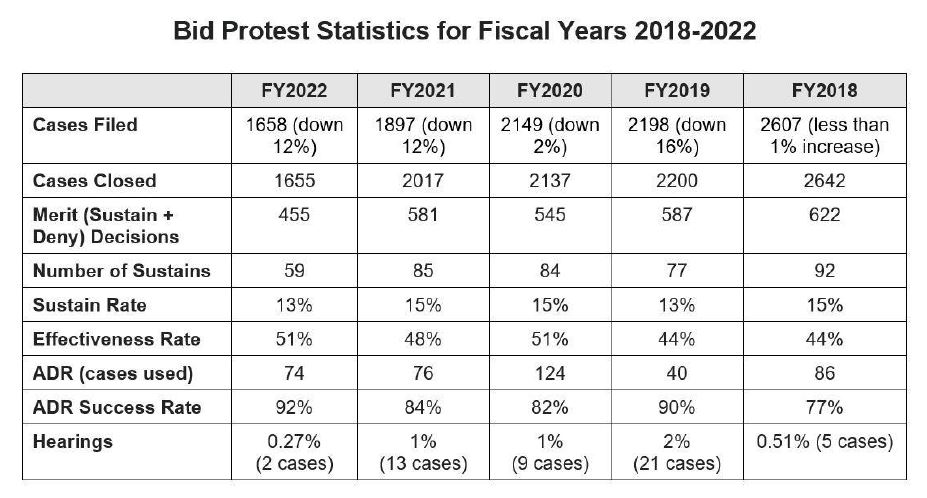Inside The GAO's Annual Bid Protest Report
Law360
The U.S. Government Accountability Office issued its annual bid protest report on Nov. 1.[1]
This year's report is noteworthy because it shows that protesters received some form of relief from the procuring agency in more than half of the protests filed with the GAO in fiscal year 2022.
In addition, the report shows that GAO bid protest filings were down for the fourth year in a row — down 12% in fiscal year 2022 alone — a trend that is part of a filing decrease that has been occurring since fiscal year 2016.
The decrease appears to be attributable in part to an increasing willingness of protesting companies to file at the U.S. Court of Federal Claims in the first instance.
Also, the more detailed information provided to disappointed offerors through the U.S. Department of Defense's enhanced post-award debriefing procedures may be weeding out some weaker protests and reducing the number of supplemental protests, which artificially raise the GAO's numbers.
Highlights
The GAO reports annually to Congress on a number of bid protest issues and uses those reports to provide data concerning its overall protest filings for the fiscal year. The highlight of this year's report is that protesters received some type of relief in 51% — just over half — of the protests closed at the GAO in fiscal year 2022.
The GAO reports this statistic as an effectiveness rate — i.e., the percentage of protests where the protester obtained "some form of relief from the agency ... either as a result of voluntary agency corrective action or [the GAO] sustaining the protest."
As the following chart from the GAO's report shows,[2] this marks the third year in a row that the effectiveness rate has been at approximately 50%.

This "effectiveness" is mostly in the form of voluntary agency corrective action, which often takes the form of a reevaluation of proposals and a revised award decision.
Taken by itself, this effectiveness figure might suggest that there is little reason not to file a bid protest, if the odds of success are the same as a coin toss that the procuring agency will either decide to take some sort of corrective action because of a risky contract award decision or else that the GAO will see merit in the protest.
Borrowing from Margaret Thatcher, is this all a matter of agencies going wobbly? Possibly, but the data suggests that something else might be going on.
The 1,658 protests filed in fiscal year 2022 represent less than two-thirds the number of protests filed in fiscal year 2018. One possible explanation is that agencies with the authority are making more use of Other Transaction Authority, or OTA, agreements, which the GAO holds are generally outside its bid protest jurisdiction.
Although increasing in popularity, OTA agreements are still somewhat uncommon, and an impact on GAO protest statistics is likely to be marginal. In addition, more use of OTA agreements, which might reduce the number of protests filed, should not have an impact on the effectiveness rate of the protests that are filed.
Another possibility is that economic disruptions resulting from the COVID-19 pandemic were a factor, but as shown on the following chart, which includes data from the fiscal year 2017 report,[3] GAO protest filings have been declining since fiscal year 2016, long before the pandemic.

The decline in protest filings is noticeably marked since fiscal year 2018. There is anecdotal evidence that a driving factor might be the increasing willingness of protesting companies to file bid protests at the U.S. Court of Federal Claims in the first instance — a trend that we expect to continue in the coming years.
Again, this scenario would reduce the number of GAO protests filed but should not have an impact on the effectiveness rate of the protests actually filed at the GAO.
Another possible explanation for the decline in GAO protest filings that would potentially have an impact on the protest effectiveness rate is that the enhanced post-award debriefing procedures implemented by the DOD, in response to Section 818 of the National Defense Authorization Act for fiscal year 2018,[4] have eliminated some of the need for information-fishing protests, due to more fulsome explanations for agency award decisions.
In addition, these enhanced debriefing procedures necessarily take longer and, thus allow disappointed offerors to cool off before deciding to protest.
While one must not confuse correlation with causation, the fact that total GAO protest numbers are declining while the proportion of successful protests is increasing strongly suggests that protesters are now filing arguably more meritorious protests than previously.
Either of these latter two scenarios could also have an outsized impact on the protest-filing figures because of a quirk in how the GAO tabulates its statistics.
As explained in footnote 1 to the GAO report, the GAO bases its numbers on the docket numbers it assigns, which include supplemental protest filings — similar to amended complaints —when information developed upon review of the evaluation record reveals new protest grounds.
If an agency takes corrective action before producing a protest record, then there is no opportunity for supplemental protest filings and, thus, the number of total protest filings is lower than it would be if a protest went to a decision on the merits.
In other words, more corrective action necessarily means that there will be fewer protests because there will be far fewer supplemental protests. And any protest filed at the Court of Federal Claims will obviously further reduce the GAO filing numbers.
Prevalent Reasons for Sustaining Protests
The GAO report states that the most prevalent reasons for sustaining protests during fiscal year 2022 were: (1) unreasonable technical evaluation; (2) flawed selection decision; and (3) flawed solicitation.[5]
Based on the foregoing, one might conclude that protest challenges to an agency's technical evaluation have the best chance of success when compared to other types of protest arguments.
But the more likely explanation that unreasonable technical evaluation continues to be the most commonly sustained protest ground is that challenges to an agency's technical evaluation are the most commonly raised protest grounds — and, as such, they are the most commonly sustained protests grounds year after year.
It is also notable that flawed solicitation was one of the most prevalent reasons that the GAO sustained protests in fiscal year 2022 because this type of pre-award protest ground has seldom shown up in past GAO's bid protest reports as being among the most prevalent reasons for the GAO sustaining protests.
The rise in sustains by the GAO of flawed solicitation arguments is likely attributable to an increase in pre-award protest filings. It may also be attributable, in part, to the increasing use by agencies of large multiple award indefinite-delivery, indefinite-quantity contracts and government wide acquisition contracts.
Solicitations for such contract vehicles are often worth challenging because competition for spots in these potentially lucrative award pools is increasingly fierce.
Takeaways
Whatever the reason for the current state of the numbers, it seems very possible that bid protest filings might increase in the near future. With the trend in the effectiveness rate, it is likely that many disappointed offerors will conclude that it would be irrational not to file a protest where there is a valid basis to do so.
In such a scenario, contract awardees would be well advised to engage early with awarding agencies to make sure that they are well-disposed to defend the awards.
Republished with permission. This article, "Inside The GAO's Annual Bid Protest Report," was published by Law360 on November 10, 2022.
[1] GAO Bid Protest Annual Report to Congress for Fiscal Year 2022 (Nov. 1, 2022), available at https://www.gao.gov/products/gao-23-900462.
[2] The chart is slightly reformatted for clarity with footnotes omitted.
[3] GAO Bid Protest Annual Report to Congress for Fiscal Year 2017 (Nov. 13, 2017), available at https://www.gao.gov/products/gao-18-237sp.
[4] Pub. L. No. 115-91, 131 Stat. 1283 (Dec. 12, 2017).
[5] As a point of comparison, the most prevalent reasons for sustaining protests during fiscal year 2021 were: (1) unreasonable technical evaluation; (2) flawed discussions; (3)
unreasonable cost or price evaluation; and (4) unequal treatment. See GAO Bid Protest Annual Report to Congress for Fiscal Year 2021 (Nov. 16, 2021), available at https://www.gao.gov/products/gao-22-900379.


